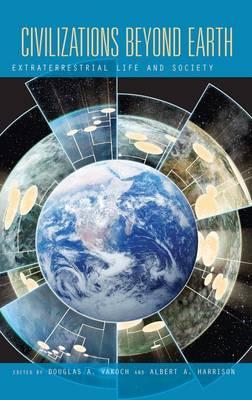Civilizations Beyond Earth: A Different Angle – Part 1
by Larry Klaes, space exploration enthusiast, science journalist, SF aficionado. The article first appeared at Centauri Dreams.
SETI, the Search for Extraterrestrial Intelligence, has traditionally operated on the premise that there may be beings in the Milky Way galaxy and beyond who are smart, aware, and interested enough to deliberately attempt to contact other similarly advanced societies in the Universe.
The primary purpose for such an effort would be to alert any potential celestial neighbors to their presence for the exchange of information and ideas about themselves, their home world, and their take on existence. Their methods of transmission would include certain forms of electromagnetic radiation which the various parties should have in common, such as radio and light waves. This Messaging to Extraterrestrial Intelligences, or METI, is considered to be not only less complex and faster than sending a robotic or crewed vessel from one star system to another – barring the discovery of a way to move faster than light (FTL) – but also far less expensive and much safer for both sides.
The alien version of METI is presumed to be conducted by scientists using not their native language but rather some form of basic mathematics for the initial efforts at getting our attention and conducting basic conversations. This remedial arithmetic would serve as the assumed common key to eventually allow both species to use their own conventional languages to exchange more detailed information.

This thinking is strongly reflected in the 1985 novel Contact (and the 1997 film version), the only major work of science fiction produced by astronomer, science popularizer, and SETI/METI pioneer Carl Sagan. In his story, Sagan envisioned a highly advanced, vast, and ancient alien technological civilization which transmits an initial message via radio waves to species they deem potentially worthy of dealing with. One day humanity receives this opening greeting from them in the form of the first one hundred prime numbers, which are digits divisible only by themselves and one. Prime numbers are a pattern produced by no known natural phenomenon.
On SETI Assumptions
If the bipedal residents of the planet Earth can detect and recognize the artificial nature of the primes being sent (“mathematics [is] the only truly universal language” declares the main character Ellie Arroway at one point in response to a visiting senator who wanted to know why the aliens didn’t just speak English) along with the subsequently more complex information which then follows, then one day we might be able join an entire galactic community of civilizations. This society would be similar to the United Nations, only on a celestial scale and with members of many different species from a diversity of alien worlds across space and time, yet somehow all managing to work together for the common cosmic good.
These assumptions, while not implausible, do reflect a particular scientific take regarding SETI, METI, and the nature and behavior of technological alien beings. The question is, does the fact that we have yet to confirm a recognizably artificial signal of extraterrestrial origin after six decades of modern SETI (and a handful of METI) activities mean that our scientific assumptions about intelligent aliens need to be revised, or have we just not been searching long and hard enough? Or perhaps both?
Since astronomer Frank Drake performed the first modern extraterrestrial hunt program in 1960 with a radio telescope search he called Ozma, SETI has traditionally been dominated by radio (and later optical) astronomers, as they are the ones who have conducted the majority of the searches for alien signals to the present era. Their parameters were and are still dictated by the contemporary limitations of what humanity can accomplish when it comes to interstellar distances and the paradigms of their fields and views on intelligent life elsewhere.
As for relevant disciplines outside of astronomy involved in SETI, there have been token representatives present going back to the first modern era SETI conferences, thanks in large part to Sagan. But usually the conferences and the projects were dominated by astronomers, who focused heavily on radio SETI and the technical details of such interstellar communications. Often they would use the famous Drake Equation (N = R* x fp x ne x fl x fi x fc x L) as their template but tend to gloss over the parts of that linear equation which were hard to quantify, which included most of it. This was especially done with fc and L, the fraction of civilizations that develop the means to let others in the galaxy know they exist and the overall lifetime of such technological societies, respectively.
Like most scientists, they felt comfortable with numbers, tangible facts, and mechanics. Why would an alien signal us? Well, because they could, so they would. They wanted to exchange knowledge because the operators had to be fellow scientists, which meant that even though they were alien, they had to think similarly to us, otherwise they would not be conducting METI/SETI. We were looking for versions of us, very specific versions if truth be told.

The accuracy of the statements is attested by Mark A. Sheriden’s excellent and insightful work titled SETI: A Critical History. From Chapter 10, Sheriden gives this quote from Dr. Jill C. Tarter, the recently retired director of the Center for SETI Research at the SETI Institute in Mountain View, California:
Not long after the [1979 NASA Life in the Universe] conference Jill Tarter, a key member of SETI’s second-generation leadership team, acknowledged that SETI was, indeed, “tuned” to find humanoids. “Those forms that we do find in this manner [i.e., a SETI-style search] will be more similar to life as we understand it than other forms that may exist. We put a filter on the problem.”
When asked what she would do differently if starting over again to study ETIs, Tarter responded with an echo of Shklovskii’s complaint prior to Byurakan-II, that the American SETI scientists failed to acknowledge the “complexity” of the problem they faced and, in particular, were ignoring the “humanities and biological aspects.” Tarter said, “I neglected biology, and civilizations, and paleontology.” In other words, she would have paid more attention to the “nature” aspects of the opportunity SETI represented.
Puzzling Out Alien Motivations
Why would an alien intelligence want to contact the stars? The possible motivations for such actions – or lack thereof – are just as important for the success of SETI and METI as figuring out how beings from another world (assuming the majority live on a planet or moon in the first place; another paradigm, perhaps?) might go about sending out signals into the galaxy.
Anthropologists, sociologists, biologists, and historians might have a clue in this area. At present they may have the native dwellers of only one planet to base their research and ideas upon, but at least it is a world with a very wide variety of life and an ancestry dating back at least 3.8 billion years.
These fields and their practitioners are given their due in the book Civilizations Beyond Earth: Extraterrestrial Life and Society, edited by Douglas A. Vakoch and Albert A. Harrison and published by Berghahn Books (New York, 2011). Vakoch, who also edited the book Communication with Extraterrestrial Intelligence (SUNY Press, New York, 2011) is the Director of Interstellar Message Composition at the SETI Institute and Professor of Clinical Psychology at the California Institute of Integral Studies. Harrison is Professor Emeritus in the Department of Psychology at the University of California, Davis.
Reading through the collected papers in Civilizations Beyond Earth reminded me of one of the first works I came across that was directly critical of the parameters modern SETI had laid down in its milestone years of 1959 and 1960, The Inner Limits of Outer Space by Dartmouth professor John C. Baird (Hanover, New Hampshire: University Press of New England, 1987). The author of the first major book on SETI by a professional psychologist, Baird was also part of Project Oasis, a NASA plan in 1979 to help design the multi-channel spectrum analyzer to be used in the space agency’s own burgeoning SETI project.
Baird pointed out how those involved in searching for extraterrestrial intelligences were spending a great deal of their time and resources in designing and building the instruments they planned to use, but not nearly as much in turn when it came to really thinking about what kind of beings might be out there and why they might want to conduct METI at all. Baird’s words and thoughts throughout The Inner Limits of Outer Space mirror what one finds twenty-four years later in Civilizations Beyond Earth. Neither work wants to do away with SETI so much as redefine it to improve the chances for success based on a more realistic or at least more open approach to alien life. The similarities also include the conclusion that even though current SETI is problematical in terms of detecting an actual extraterrestrial signal, it cannot hurt to keep trying for, to quote the current advertising motto of the New York State Lottery: “You never know.”
Among the highlights of Civilizations Beyond Earth which take it beyond the usual examinations of SETI and its related fields is the focus on what the general public, or laypersons, think and say about extraterrestrial life, in particular the intelligent kind.


